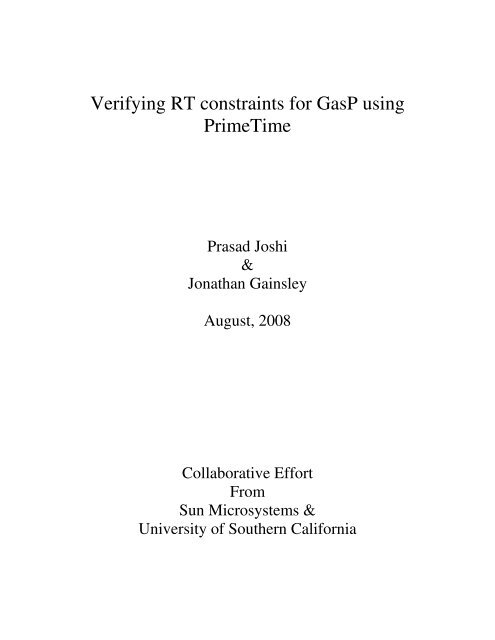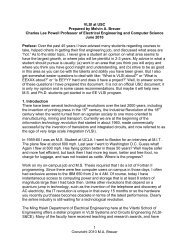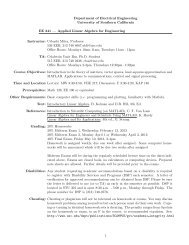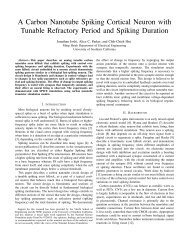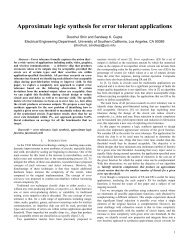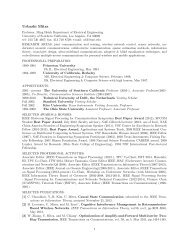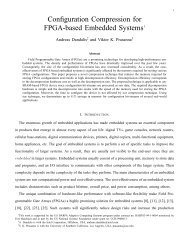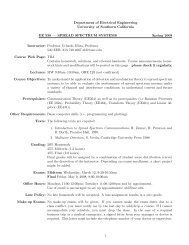Verifying RT constraints for GasP using PrimeTime - University of ...
Verifying RT constraints for GasP using PrimeTime - University of ...
Verifying RT constraints for GasP using PrimeTime - University of ...
You also want an ePaper? Increase the reach of your titles
YUMPU automatically turns print PDFs into web optimized ePapers that Google loves.
<strong>Verifying</strong> <strong>RT</strong> <strong>constraints</strong> <strong>for</strong> <strong>GasP</strong> <strong>using</strong><br />
<strong>PrimeTime</strong><br />
Prasad Joshi<br />
&<br />
Jonathan Gainsley<br />
August, 2008<br />
Collaborative Ef<strong>for</strong>t<br />
From<br />
Sun Microsystems &<br />
<strong>University</strong> <strong>of</strong> Southern Cali<strong>for</strong>nia
Creation <strong>of</strong> <strong>GasP</strong> liberty file:<br />
The first step in per<strong>for</strong>ming a Static Timing Analysis (STA) over any architecture is to<br />
create a timing model <strong>for</strong> the particular architecture. We chose to use the Synopsys<br />
Liberty Format (.lib) <strong>for</strong> representing the timing model because we are <strong>using</strong> Synopsys<br />
Primetime <strong>for</strong> STA. The following section describes the steps which were taken towards<br />
creation <strong>of</strong> the .lib.<br />
<strong>GasP</strong> Architecture<br />
The following figure gives a pictorial description <strong>of</strong> the <strong>GasP</strong> Plain cell:<br />
As depicted in the above figure, the <strong>GasP</strong> cells have two bidirectional pins namely the<br />
predecessor (P) and the successor (S), and one output pin which is the Fire (F) signal. It<br />
was my initial perception that since there exists an arc from P F and also an arc from<br />
F S, the pin F should be defined as an inout (i.e. bidirectional) in the .lib. In order to<br />
represent the behavior <strong>of</strong> the <strong>GasP</strong> cell, I created a fake .lib which had the <strong>GasP</strong> Plain cell<br />
with three bi-directional pins. This .lib along with a Verilog representation <strong>of</strong> a 5-stage<br />
linear pipeline was then given to Primetime <strong>for</strong> analysis. Using the<br />
report_delay_calculation command, I could identify the various arcs interpreted by<br />
Primetime.<br />
This command reported arcs from P F and from F S, but couldn’t establish an<br />
entire path from P S. As a result <strong>of</strong> this, I concluded the following:<br />
1. The path was being cut at F<br />
I also postulated that:<br />
2. This problem could be due the presence <strong>of</strong> the bi-directional pins on the channels.<br />
Assuming that the bidirectional pins on P and S were the problem, I created another .lib<br />
with pins on the channels being separated into 2 separate input and output pins. An<br />
abstract drawing <strong>of</strong> this split pin architecture is shown in the following figure:<br />
2
The legend <strong>for</strong> the above figure is as follows:<br />
Pi - input from Predecessor<br />
Po - output to Predecessor<br />
Si - input from Successor<br />
So - output to Successor<br />
F - Fire Signal<br />
A typical 3 stage pipeline is shown in the following figure <strong>for</strong> a clearer understanding.<br />
Equipped with the new .lib, I again ran Primetime on the same 5-stage pipeline. I had<br />
kept the F pin as an inout pin in this .lib as well. Again the result was the same as be<strong>for</strong>e.<br />
In this Primetime run as well, primetime recognized that there is an arc from Pi F and<br />
also an arc from F So, but it couldn’t recognize the path between Pi So.<br />
Now, the conclusion was evident, that primetime was breaking the path at F. Upon<br />
inspection I found out that, whenever a pin in defined as an “inout”, Primetime defines 2<br />
ports, namely an input port and an output port <strong>for</strong> the same pin. It is also a characteristic<br />
3
<strong>of</strong> Primetime to thereby cut timing paths within the same cell at all input ports. Hence the<br />
input(Pi)-to-output(So) was getting cut at input(F). To overcome this problem I had to<br />
define F as an output port. This solved the problem <strong>for</strong> both the .lib’s created till now. It<br />
is important to note that Primetime has no problems accepting output-to-output arcs,<br />
which in this case will be from F S.<br />
I then used the corrected .lib which is same as the first one except <strong>for</strong> the change in the<br />
direction <strong>of</strong> pin F, <strong>for</strong> further analysis. Using check_timing command, I could identify the<br />
timing loops that are inadvertently present in the <strong>GasP</strong> design. These loops can be broken<br />
manually at the desired places <strong>using</strong> set_disable_timing. I was able to calculate the<br />
<strong>for</strong>ward latency, by disabling the arcs on the backward path <strong>of</strong> the timing loops. Similarly<br />
the reverse latency <strong>of</strong> the design can be measured by disabling the arcs on the <strong>for</strong>ward<br />
path.<br />
Both the .lib’s produced the exact same results and the bidirectional channel pins in the<br />
first design seemed to be working well.<br />
<strong>Verifying</strong> the Relative Timing (<strong>RT</strong>) <strong>constraints</strong> defined at<br />
USC<br />
I then moved towards verifying the timing <strong>constraints</strong>, I had defined in the document<br />
Fleet_Analysis.V3.2. The far input loop constraint on the output channel (O-FIL) was<br />
arbitrarily chosen by me <strong>for</strong> verification. The two paths that need to be measured are as<br />
follows:<br />
1. F+ S+<br />
2. F+ P- F- (or Fbar+)<br />
The second path here clearly suggests that we want Primetime to verify the delay through<br />
a cycle without breaking it. This was not possible as Primetime will break the cycle and<br />
hence we will get incorrect numbers.<br />
As suggested by Dr. Beerel, I created a fake pin named (Fclk) in the .lib to break the<br />
second timing path as follows:<br />
F+ P- Fclk-<br />
This new .lib still had the bidirectional pins at the channels. It has been my emphasis to<br />
try and make Primetime understand the bi-directional pins as much as possible. The Split<br />
pin architecture was the final resort.<br />
In order to see, whether the different paths were created, I used report_delay_calculation<br />
and report_timing.<br />
The STA approach developed by Mallika Prakash <strong>of</strong> USC was used to verify the above<br />
mentioned constraint as follows:<br />
1. Create a clock pin on the POD<br />
4
2. Verify the difference between the two paths <strong>using</strong> set_data_check<br />
For trial purposes, I created a clock on the F pin <strong>of</strong> the 2 nd stage <strong>of</strong> the linear pipeline.<br />
When I used set_data_check on the 2 paths namely F+ S+ and F+ P- Fclk-, I<br />
didn’t get any results.<br />
On further analysis I did report_timing on the path F Fclk, and it showed me that there<br />
were no constraint paths. On explicitly specifying the path as rise_from F to fall_to Fclk,<br />
primetime showed me that the path doesn’t exist. My conclusion from these observations<br />
is as follows:<br />
1. Due to the presence <strong>of</strong> the bidirectional pin P in the path <strong>of</strong> F+ to Fclk-,<br />
Primetime breaks the timing path at P. Note that P also serves as “input” and<br />
primetime breaks timing paths internal to the cell passing through the “input” pins.<br />
2. I need to make another .lib ☺<br />
This new .lib had the bidirectional channel pins split into 2 pins and also had a separate<br />
Fclk pin as a fake pin <strong>for</strong> verifying the <strong>RT</strong> <strong>constraints</strong>. This .lib is shown in the Appendix<br />
A. I have also attached the Verilog file and the associated .tcl file in Appendix B and<br />
Appendix C respectively.<br />
This .lib allows us to verify all the timing <strong>constraints</strong> that were defined in the document<br />
Fleet_Analysis.V3.2. The timing reports <strong>for</strong> the four major <strong>constraints</strong> can be seen in<br />
Appendix D-G.<br />
Future Tasks:<br />
Establish a similar flow to verify that <strong>GasP</strong> control circuits meet the relative timing<br />
<strong>constraints</strong> <strong>for</strong> the data latches.<br />
5
Appendix A (The final .lib !!!)<br />
library(GASP2) {<br />
technology(cmos);<br />
delay_model : table_lookup;<br />
library_features(report_delay_calculation);<br />
time_unit : "1ns";<br />
capacitive_load_unit (1.0,ff);<br />
voltage_unit : "1V";<br />
current_unit : "1uA";<br />
pulling_resistance_unit : "1kohm";<br />
leakage_power_unit : "1nW";<br />
slew_upper_threshold_pct_rise : 70;<br />
slew_lower_threshold_pct_rise : 30;<br />
slew_upper_threshold_pct_fall : 70;<br />
slew_lower_threshold_pct_fall : 30;<br />
input_threshold_pct_rise : 30;<br />
input_threshold_pct_fall : 70;<br />
output_threshold_pct_rise : 30;<br />
output_threshold_pct_fall : 70;<br />
nom_process : 1;<br />
nom_voltage : 1.8;<br />
nom_temperature : 25;<br />
default_leakage_power_density : 0.0;<br />
default_cell_leakage_power : 0.0;<br />
default_fanout_load : 1.0;<br />
default_output_pin_cap : 0.0;<br />
default_inout_pin_cap : 0.0;<br />
default_input_pin_cap : 0.0;<br />
operating_conditions (typical) {<br />
process : 1;<br />
voltage : 1.8;<br />
temperature : 25;<br />
}<br />
default_operating_conditions : typical;<br />
lu_table_template(delay_template_cap_P_plain_6x1) {<br />
variable_1 : total_output_net_capacitance;<br />
index_1 ("10,15,20,25,30,35");<br />
}<br />
lu_table_template(delay_template_P_rise_plain_6x1) {<br />
variable_1 : input_net_transition;<br />
index_1 ("0.1,0.2,0.3,0.4,0.5,0.6");<br />
}<br />
lu_table_template(delay_template_P_fall_plain_6x1) {<br />
variable_1 : input_net_transition;<br />
index_1 ("0.1,0.2,0.3,0.4,0.5,0.6");<br />
6
}<br />
lu_table_template(delay_template_S_rise_plain_6x1) {<br />
variable_1 : input_net_transition;<br />
index_1 ("0.1,0.2,0.3,0.4,0.5,0.6");<br />
}<br />
lu_table_template(delay_template_S_fall_plain_6x1) {<br />
variable_1 : input_net_transition;<br />
index_1 ("0.1,0.2,0.3,0.4,0.5,0.6");<br />
}<br />
lu_table_template(delay_template_cap_S_plain_6x1) {<br />
variable_1 : total_output_net_capacitance;<br />
index_1 ("10,15,20,25,30,35");<br />
}<br />
cell(GASP_PLAIN) {<br />
cell_leakage_power : 0.0;<br />
pin (Pi) {<br />
direction : input;<br />
capacitance : 10;<br />
}<br />
pin (Po) {<br />
direction : output;<br />
capacitance : 10;<br />
timing() {<br />
}<br />
related_pin : "F";<br />
timing_type : combinational_fall;<br />
timing_sense : negative_unate;<br />
cell_fall(delay_template_cap_P_plain_6x1) {<br />
values("1,2,3,4,5,6");<br />
}<br />
fall_transition(delay_template_cap_P_plain_6x1) {<br />
values("0.1,0.2,0.3,0.4,0.5,0.6");<br />
}<br />
}<br />
pin (F) {<br />
direction : output;<br />
capacitance : 10;<br />
timing() {<br />
related_pin : "Pi";<br />
timing_type : combinational_rise;<br />
timing_sense : positive_unate;<br />
cell_rise(delay_template_P_rise_plain_6x1) {<br />
values("1,2,3,4,5,6");<br />
}<br />
7
timing() {<br />
}<br />
rise_transition(delay_template_P_rise_plain_6x1) {<br />
values("0.1,0.2,0.3,0.4,0.5,0.6");<br />
}<br />
}<br />
related_pin : "Si";<br />
timing_type : combinational_rise;<br />
timing_sense : negative_unate;<br />
cell_rise(delay_template_S_rise_plain_6x1) {<br />
values("1,2,3,4,5,6");<br />
}<br />
rise_transition(delay_template_S_rise_plain_6x1) {<br />
values("0.1,0.2,0.3,0.4,0.5,0.6");<br />
}<br />
}<br />
pin (Fclk) {<br />
direction : output;<br />
capacitance : 10;<br />
timing() {<br />
related_pin : "Po";<br />
timing_type : combinational_fall;<br />
timing_sense : positive_unate;<br />
cell_fall(delay_template_P_fall_plain_6x1) {<br />
values("1,2,3,4,5,6");<br />
}<br />
fall_transition(delay_template_P_fall_plain_6x1) {<br />
values("0.1,0.2,0.3,0.4,0.5,0.6");<br />
}<br />
}<br />
timing() {<br />
}<br />
related_pin : "So";<br />
timing_type : combinational_fall;<br />
timing_sense : negative_unate;<br />
cell_fall(delay_template_S_fall_plain_6x1) {<br />
values("1,2,3,4,5,6");<br />
}<br />
fall_transition(delay_template_S_fall_plain_6x1) {<br />
values("0.1,0.2,0.3,0.4,0.5,0.6");<br />
}<br />
}<br />
pin (Si) {<br />
direction : input;<br />
capacitance : 10;<br />
8
}<br />
}<br />
pin (So) {<br />
direction : output;<br />
capacitance : 10;<br />
}<br />
timing() {<br />
}<br />
related_pin : "F";<br />
timing_type : combinational_rise;<br />
timing_sense : positive_unate;<br />
cell_rise(delay_template_cap_S_plain_6x1) {<br />
values("1,2,3,4,5,6");<br />
}<br />
rise_transition(delay_template_cap_S_plain_6x1) {<br />
values("0.1,0.2,0.3,0.4,0.5,0.6");<br />
}<br />
}<br />
9
Appendix B (verilog file <strong>for</strong> the linear pipeline)<br />
module GASP_PLAIN (Pi,Po,F,Fclk,Si,So);<br />
input Pi;<br />
output F;<br />
output Fclk;<br />
input Si;<br />
output Po;<br />
output So;<br />
endmodule<br />
module GASP_PIPE(Pin,Pout,Sin,Sout);<br />
input Pin;<br />
output Pout;<br />
input Sin;<br />
output Sout;<br />
wire<br />
S1in,S1out,S2in,S2out,S3in,S3out,S4in,S4out,F1,F2,F3,F4,F5,F1c,F2c,F3c,<br />
F4c,F5c;<br />
GASP_PLAIN I1<br />
(.Pi(Pin),.Po(Pout),.F(F1),.Fclk(F1c),.Si(S1in),.So(S1out));<br />
GASP_PLAIN I2<br />
(.Pi(S1out),.Po(S1in),.F(F2),.Fclk(F2c),.Si(S2in),.So(S2out));<br />
GASP_PLAIN I3<br />
(.Pi(S2out),.Po(S2in),.F(F3),.Fclk(F3c),.Si(S3in),.So(S3out));<br />
GASP_PLAIN I4<br />
(.Pi(S3out),.Po(S3in),.F(F4),.Fclk(F4c),.Si(S4in),.So(S4out));<br />
GASP_PLAIN I5<br />
(.Pi(S4out),.Po(S4in),.F(F5),.Fclk(F5c),.Si(Sin),.So(Sout));<br />
endmodule<br />
10
Appendix C (final .tcl script used <strong>for</strong> verification)<br />
set netlist gasp4.v<br />
set top GASP_PIPE<br />
read_lib gasp4.lib<br />
read_verilog $netlist<br />
set link_path "GASP2 $netlist"<br />
echo $link_path<br />
link_design -keep_sub_designs $top<br />
check_timing -include loops -verbose<br />
#uncomment to verify one <strong>of</strong> the following four <strong>constraints</strong><br />
#O-FIL<br />
#set_disable_timing -from Si -to F [ get_cells -hierarchical * ]<br />
#create_clock -period 10.0 I2/F<br />
#set_data_check -clock I2/F -rise_to I3/Pi -fall_from I2/Fclk -setup<br />
1.5<br />
#I-FOL<br />
#set_disable_timing -from Pi -to F [ get_cells -hierarchical * ]<br />
#create_clock -period 10.0 I2/F<br />
#set_data_check -clock I2/F -fall_to I1/Si -fall_from I2/Fclk -setup<br />
1.5<br />
#fwd short circuit (O-SC)<br />
#set_disable_timing -from Si -to F [ get_cells -hierarchical * ]<br />
#set_disable_timing -from F -to Po [ get_cells -hierarchical * ]<br />
#create_clock -period 10.0 I2/F<br />
#set_data_check -clock I2/F -rise_to I3/F -fall_from I2/Fclk -setup 0.5<br />
#rev short circuit (I-SC)<br />
#set_disable_timing -from Pi -to F [ get_cells -hierarchical * ]<br />
#set_disable_timing -from F -to So [ get_cells -hierarchical * ]<br />
#create_clock -period 10.0 I2/F<br />
#set_data_check -clock I2/F -rise_to I1/F -fall_from I2/Fclk -setup 0.5<br />
report_timing<br />
11
Appendix D (timing report <strong>for</strong> O-FIL)<br />
****************************************<br />
Report : timing<br />
-path_type full<br />
-delay_type max<br />
-max_paths 1<br />
Design : GASP_PIPE<br />
Version: A-2007.12-SP3<br />
Date : Thu Jun 5 16:52:41 2008<br />
****************************************<br />
Startpoint: I2/F (clock source 'I2/F')<br />
Endpoint: I3 (falling edge-triggered data to data check clocked by<br />
I2/F)<br />
Path Group: I2/F<br />
Path Type: max<br />
1<br />
Point Incr Path<br />
---------------------------------------------------------------<br />
clock I2/F (rise edge) 0.00 0.00<br />
clock source latency 0.00 0.00<br />
I2/F (GASP_PLAIN) 0.00 0.00 r<br />
I2/So (GASP_PLAIN) 3.00 3.00 r<br />
I3/Pi (GASP_PLAIN) 0.00 3.00 r<br />
data arrival time 3.00<br />
clock I2/F (rise edge) 0.00 0.00<br />
clock source latency 0.00 0.00<br />
I2/F (GASP_PLAIN) 0.00 0.00 r<br />
I2/Po (GASP_PLAIN) 3.00 3.00 f<br />
I2/Fclk (GASP_PLAIN) 3.00 6.00 f<br />
data check setup time -1.50 4.50<br />
data required time 4.50<br />
---------------------------------------------------------------<br />
data required time 4.50<br />
data arrival time -3.00<br />
---------------------------------------------------------------<br />
slack (MET) 1.50<br />
12
Appendix E (timing report <strong>for</strong> I-FOL)<br />
****************************************<br />
Report : timing<br />
-path_type full<br />
-delay_type max<br />
-max_paths 1<br />
Design : GASP_PIPE<br />
Version: A-2007.12-SP3<br />
Date : Thu Jun 5 16:54:34 2008<br />
****************************************<br />
Startpoint: I2/F (clock source 'I2/F')<br />
Endpoint: I1 (falling edge-triggered data to data check clocked by<br />
I2/F)<br />
Path Group: I2/F<br />
Path Type: max<br />
1<br />
Point Incr Path<br />
---------------------------------------------------------------<br />
clock I2/F (rise edge) 0.00 0.00<br />
clock source latency 0.00 0.00<br />
I2/F (GASP_PLAIN) 0.00 0.00 r<br />
I2/Po (GASP_PLAIN) 3.00 3.00 f<br />
I1/Si (GASP_PLAIN) 0.00 3.00 f<br />
data arrival time 3.00<br />
clock I2/F (rise edge) 0.00 0.00<br />
clock source latency 0.00 0.00<br />
I2/F (GASP_PLAIN) 0.00 0.00 r<br />
I2/Po (GASP_PLAIN) 3.00 3.00 f<br />
I2/Fclk (GASP_PLAIN) 3.00 6.00 f<br />
data check setup time -1.50 4.50<br />
data required time 4.50<br />
---------------------------------------------------------------<br />
data required time 4.50<br />
data arrival time -3.00<br />
---------------------------------------------------------------<br />
slack (MET) 1.50<br />
13
Appendix F (timing report <strong>for</strong> O-SC)<br />
****************************************<br />
Report : timing<br />
-path_type full<br />
-delay_type max<br />
-max_paths 1<br />
Design : GASP_PIPE<br />
Version: A-2007.12-SP3<br />
Date : Thu Jun 5 16:56:07 2008<br />
****************************************<br />
Startpoint: I2/F (clock source 'I2/F')<br />
Endpoint: I3 (falling edge-triggered data to data check clocked by<br />
I2/F)<br />
Path Group: I2/F<br />
Path Type: max<br />
1<br />
Point Incr Path<br />
---------------------------------------------------------------<br />
clock I2/F (rise edge) 0.00 0.00<br />
clock source latency 0.00 0.00<br />
I2/F (GASP_PLAIN) 0.00 0.00 r<br />
I2/So (GASP_PLAIN) 3.00 3.00 r<br />
I3/F (GASP_PLAIN) 3.00 6.00 r<br />
data arrival time 6.00<br />
clock I2/F (rise edge) 0.00 0.00<br />
clock source latency 0.00 0.00<br />
I2/F (GASP_PLAIN) 0.00 0.00 r<br />
I2/So (GASP_PLAIN) 3.00 3.00 r<br />
I2/Fclk (GASP_PLAIN) 3.00 6.00 f<br />
data check setup time -0.50 5.50<br />
data required time 5.50<br />
---------------------------------------------------------------<br />
data required time 5.50<br />
data arrival time -6.00<br />
---------------------------------------------------------------<br />
slack (VIOLATED) -0.50<br />
14
Appendix G (timing report <strong>for</strong> I-SC)<br />
****************************************<br />
Report : timing<br />
-path_type full<br />
-delay_type max<br />
-max_paths 1<br />
Design : GASP_PIPE<br />
Version: A-2007.12-SP3<br />
Date : Thu Jun 5 16:57:19 2008<br />
****************************************<br />
Startpoint: I2/F (clock source 'I2/F')<br />
Endpoint: I1 (falling edge-triggered data to data check clocked by<br />
I2/F)<br />
Path Group: I2/F<br />
Path Type: max<br />
1<br />
Point Incr Path<br />
---------------------------------------------------------------<br />
clock I2/F (rise edge) 0.00 0.00<br />
clock source latency 0.00 0.00<br />
I2/F (GASP_PLAIN) 0.00 0.00 r<br />
I2/Po (GASP_PLAIN) 3.00 3.00 f<br />
I1/F (GASP_PLAIN) 3.00 6.00 r<br />
data arrival time 6.00<br />
clock I2/F (rise edge) 0.00 0.00<br />
clock source latency 0.00 0.00<br />
I2/F (GASP_PLAIN) 0.00 0.00 r<br />
I2/Po (GASP_PLAIN) 3.00 3.00 f<br />
I2/Fclk (GASP_PLAIN) 3.00 6.00 f<br />
data check setup time -0.50 5.50<br />
data required time 5.50<br />
---------------------------------------------------------------<br />
data required time 5.50<br />
data arrival time -6.00<br />
---------------------------------------------------------------<br />
slack (VIOLATED) -0.50<br />
15


